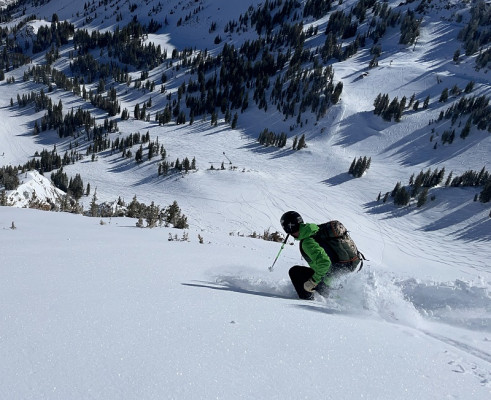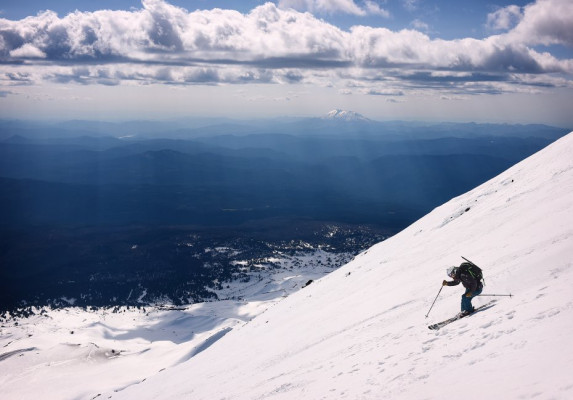5/2/2022 Near and Far: Finding The Less Trafficked Wasatch Drainages
By Spencer Dillon
I have an upper limit on how many times I will ski the staples of the Central Wasatch every year. I’ve grown tired of that moment when, looking back towards the two main roads in the Wasatch, I think, ‘Here we go again, I guess.' It feels stale, the gilded cage. Zero approach skiing in the deepest snow in Utah in stimulating but navigable terrain can feel like… a bummer? Contending with the hordes, it can feel blech for the terribly spoiled among us. The same struggles to avoid skiing hot pow, the same pleasant, luge-y exits, the same good spots over, and over, and over.
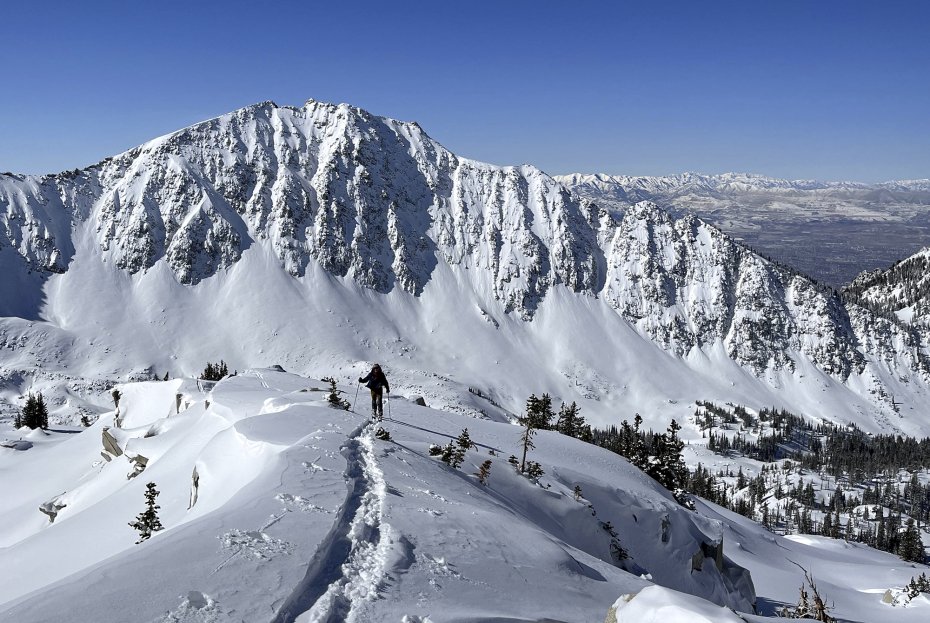
I learned recently, however, that we are allowed to ski other drainages in the Wasatch! If you like scrub oak, rocks, and breaking trail, the range can feel quite large. This season, I’ve been trying to break more out of the ‘best’ skiing to see more of the less trafficked fringes with stupid approaches and less stable snow, and boy has it been fun.
The most recent such endeavor was a two-night trip into upper Bell’s Canyon. We wanted to camp to taste some of the serenity that comes with not touring before something and after something else, that is squeezed into life in Salt Lake. Its long approach and debatably worthwhile skiing helps keep the riff raff out. The goal was to ski the Northeast Couloir on Lone Peak on our way towards other exciting terrain in the Hogum/Bell’s neighborhood. As with my other poorly-conceived plans, the snowpack did not quite support our optimism, and plans had to change. Thankfully, my roommate Calum knew what to expect from me. He’s taken to always bringing an axe and crampons just in case I start a sentence with, ‘oooh maybe we should…’
Looking up the south face of Lone Peak to its stormy summit, 5,000 feet away, the plan seemed pretty hairball. Upper elevations had received a foot of new snow covering the bountiful rock harvest from our low-tide snowpack. The top thousand feet of Lone Peak was inside a roiling ping pong ball, and the thermometer read maybe 20 degrees down in town. And it was new terrain for both of us, with overnight packs, at 3pm, on our way to a camp as yet unknown. Great idea, right? It sounds so considered and thoughtful even when writing it out now.
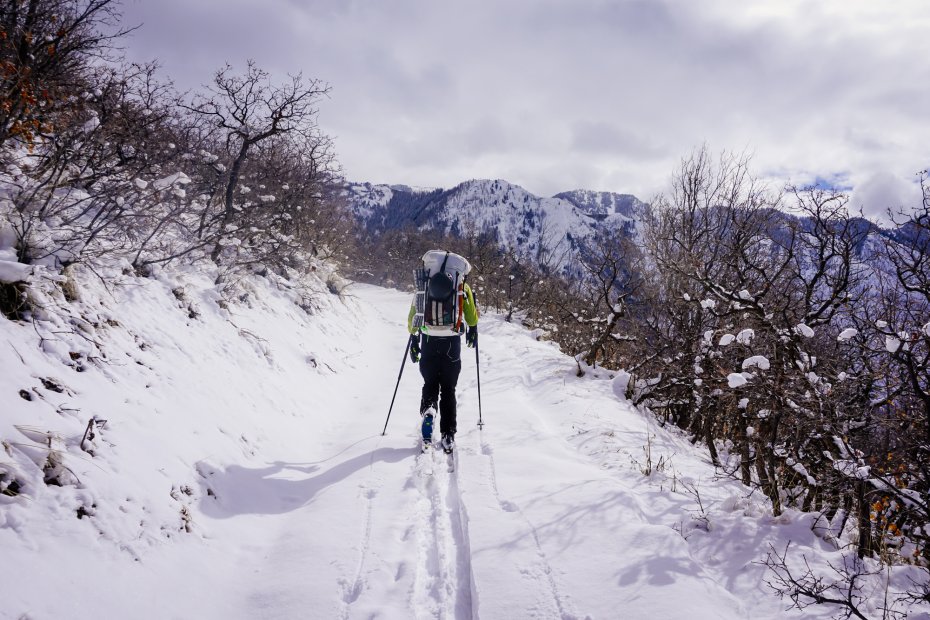
Having skied God’s Halfpipe before, I knew the approach from Alpine would be long and start very low. Jeep tracks snake up the oaky, southern meadows of Lone Peak for thousands of feet before opening the pines and granite we’re used to in the central Wasatch. My hopes for skinning from the car were low, considering our poor snow year and the trailhead being behind somebody’s house at 5,500’, but there we were, within sight of the car, throwing skis (gently) onto the 3” of snow on the road. It was both blessed relief and an hour of significant puckering. The sound of our skis losing grip and skittering across the gravel was thankfully rare, and there was no breadcrumb trail of skin material behind us, just a dusting.
As we skinned, it became obvious that we were not going to onsight the Northeast Couloir with overnight packs on, as the recent storm - the summit was still totally socked in. Skiing a big line with 60-liter bags, thin coverage, and a foot of unconsolidated new snow in a whiteout didn’t seem like a great idea to us. It was also well below zero degrees by that point and getting significantly colder. Recipe for success, right? Right. Better to ski down into upper Bells and keep options open for the next two days. But the snow was so deep and cold that our skinny little nerd-skis couldn’t plow through. So, after skinning all the way up from Alpine, the skins came back out for deep, downhill trail/heart breaking into Bells.
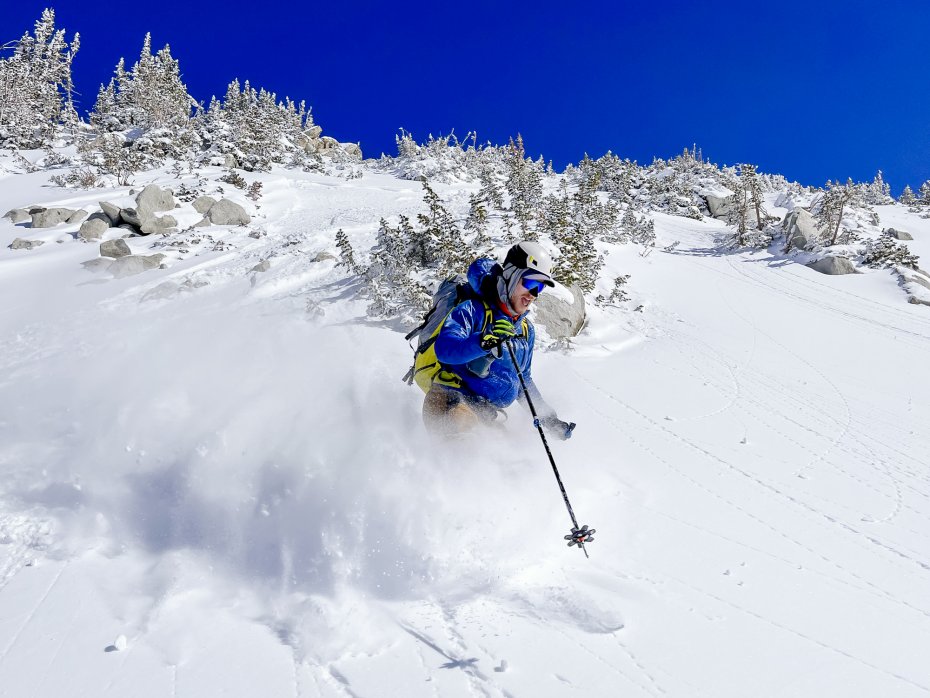
As anyone could guess, we didn’t end up skiing Lone Peak. Once in Bells, we found a protected clearing to camp in and flopped over, exhausted, in the new snow. With some scary facets under that new snow, we decided to stick to the excellent dad pow glades available near our tent. Thousand-foot shots of incredible, low-angle snow full of sneaky granite sharks abounded, and we were excited to ski our little hearts out once we got settled. I briefly floated the idea of a 500’ lap after we set up the tent, but I think we ended up falling asleep around 6:30, zipped up to our noses in layer after layer after layer of down.
Bells doesn’t get much ski traffic from what I know. There’s almost no way in that doesn’t involve low elevation walking, steep, boulder-y skinning, and significant avalanche exposure. Add in an incredibly rocky basin with thin coverage and not much good skiing within 3000’ of a trailhead and you have yourself a private drainage. We saw a single set of impressive tracks put in during our three days and I was honestly surprised to see any evidence of other skiers. I love bullshit and the bullshit factor to get into upper Bells was high.
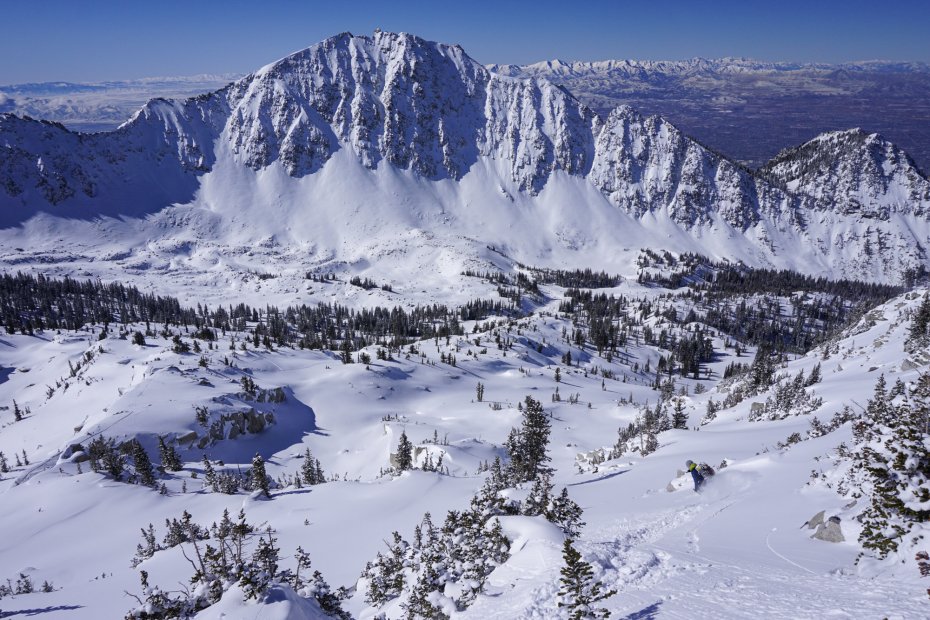
The next morning was bluebird and just a titch warmer. The Northeast Couloir abandoned, we looked up towards the western shots off of South Thunder Mountain. I’m no geologist, but the arrangement and size of rocks in upper Bells felt different from central Wasatch. Less beaten down by glaciers perhaps? It was full of raw, exfoliating granite boulders and very little soil in between. Every rollover was slabby granite and the subridges heading up the western flank of South Thunder were composed of enormous, singular chunks of rock. Not as cool as the Northeast Couloir on Lone Peak, obviously. But less deathy.
As we lapped the upper basin, Calum and I poked around the South Thunder ridgeline for a sneak into Hogum Fork. Exiting Bells promised to be painful and arduous, whereas a Hogum exit would hold significantly more skiing and less walking. I had a point on my gps from a friend for a “Bells/Hogum sneak”, which, given all the rock climbing in there, would be quite the sneak. So we were out, trying to get an angle on the supposed south-facing sneak. Trying to see it without plummeting Hogum’s Heros or kicking off a fresh cornice, anyway. The terrain is very steep. In the 80-90 degree range for about 1000’ down all along the ridge. There’s a bunch of great rock climbing there in the summer. But we didn’t bring a bolt kit and 60m of rappel cord, however. Being dad pow skiers, we had a strict skis-on-snow policy. So we were looking for a skis-on-snow exit into Hogum and away from lower Bells’ certain schwacking.
As we walked the granite tongues of the ridge, craning our necks to see our supposed sneak, we gave wide berths to the obvious and fresh cornices around us. It would have been a base jump into Hogum if.. if if if. So we didn’t want to if. But, as we stumbled back to our skis, I knocked a car-sized cornice off from within 2’ of the fracture line. The woosh it made was less emphatic than I expected, and I watched it fall ponderously, almost struggling to accelerate. Laying on my stomach on one of the horizontal pillars that line the upper Hogum ridgeline to get a better look, I couldn’t see the base of the cliff or even the cornice’s crater in the snow.
That shook us. It was disarming, in a sense, having such a close call in such extreme terrain while skiing 30-degree bowls just feet in the other direction. Calum and I sat there, hugging each other and breathing deeply. I kept looking over at the hole in the ridge where the cornice had been and my footprints on the verge of the void. That was a close one. A really close one. Who knew glade skiing could be so dangerous?
Turning back toward Bells and looking out at the valley, I felt somehow further from the road than usual while skiing in the Wasatch. We had gotten a peak at our ‘sneak’. Not a sneak. We would be exiting Bells. Looking down the arching hook of the drainage towards Highland Drive, 215, and my house in Cottonwood Heights, the road felt bizarrely far in our little range. An irony, given what a view of the valley we had. Walking out of Bells was going to be a bear, but at least the skis would stay on the snow and the snow would stay put.
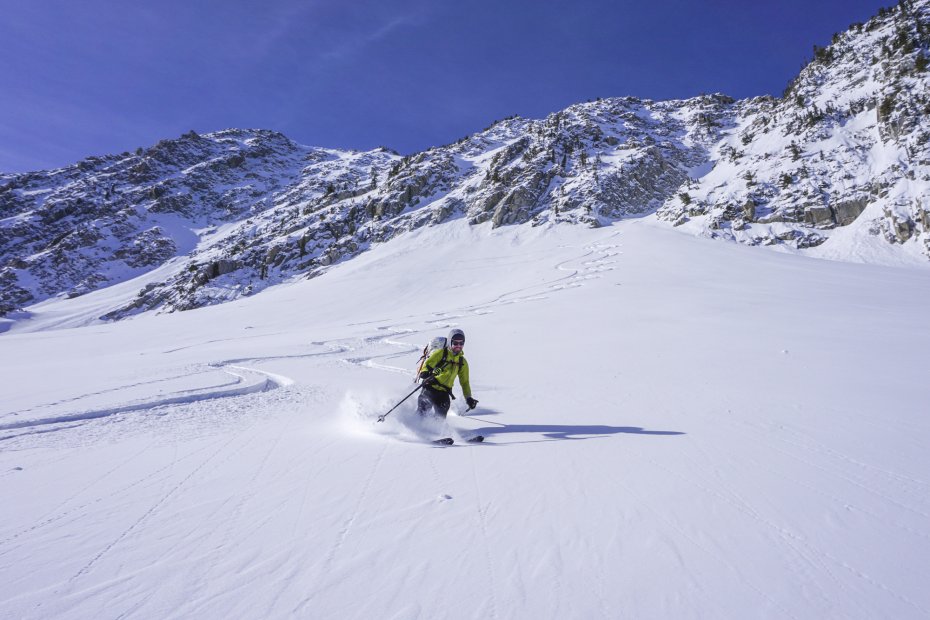
The next morning, after a significantly sweatier night in our cocoons, we skinned the apron of the east face of Lone Peak, scooting over in the basin for an easier egress and some open turns on that beautiful face. Above us was a maze of hanging snowfields and improbable couloirs. A full pack tottered on my hips, hastily packed for an early exit. Calum’s bag was, of course, better. But the face, rocky, thin and streaked with sluffs, loomed. A nibble on the apron of our face was all we had the time and inclination for, but it justified the whole trip. My frost-nipped nose, the frozen contact solution and food, the gloves layered over gloves, the thousands of feet of downhill walking that awaited us, the downhill skinning: it was all worth it. The face was gorgeous, and standing at the base of it, craning my neck to see the ridge above, I felt connected to mountains in a way I rarely do in the Wasatch. We had walked from the valley, and would be returning to the valley on foot. This moment was the apogee of our tiny pilgrimage, and we were specks in the midst of grandeur. From dirt to dirt, valley floor to valley floor.
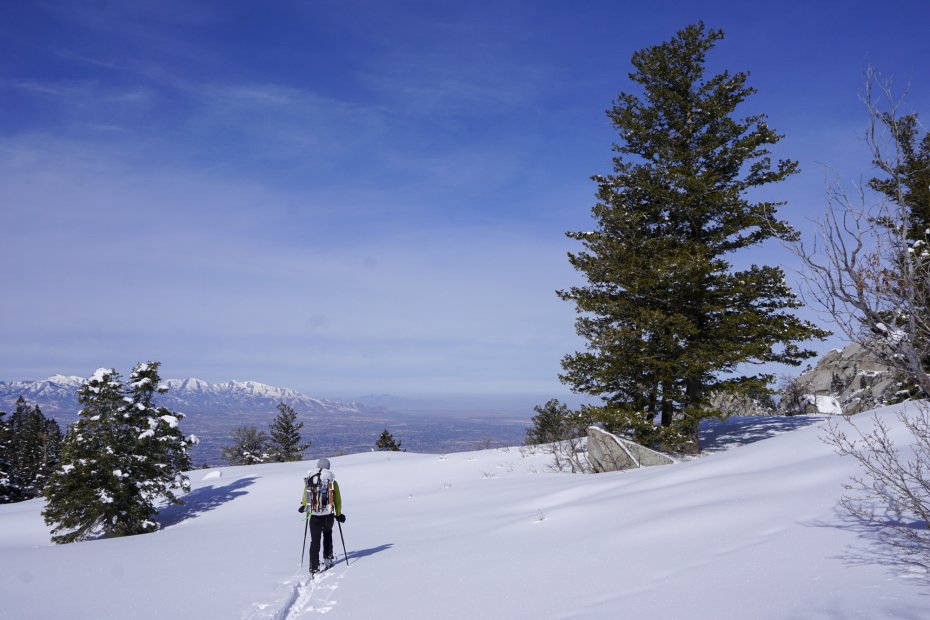
Not that I’m religious. Far from it. But ski touring feels like going to ski church. It is moving worship of the act, the place, and the people. Standing above the beautiful skiing that awaited us and below the intimidating face that would require more penance to experience, looking over at Calum standing next to me, I was moved towards reverie. There we were, enjoying the fruits of our labors over the past days but also the past seasons, our flowering partnership, fitness, mountain sense, and joy. All of that work, though it rarely felt like it at the time, brought us to this place, this spiritual moment of communion with a sacred place. Here, far from the hubbub of the upper Cottonwoods, the hills are still allowed to be, untrammeled and untracked. The snow falls and melts on its own. There are no moguls and no buried tracks. There is no human pressure to be skiable. The mountains are allowed to be outside of us. We came to them.
Comments
